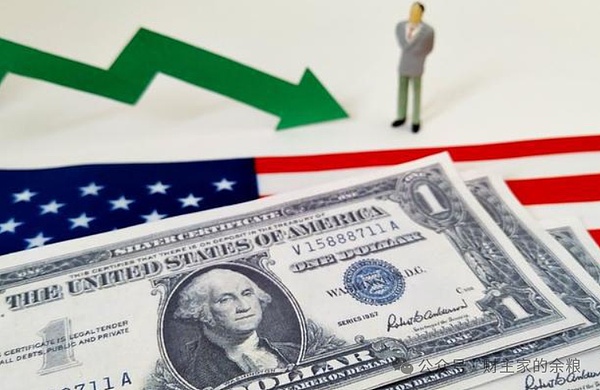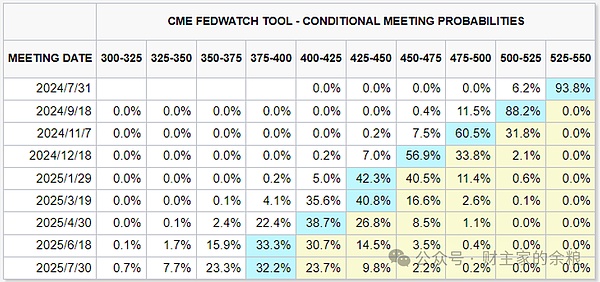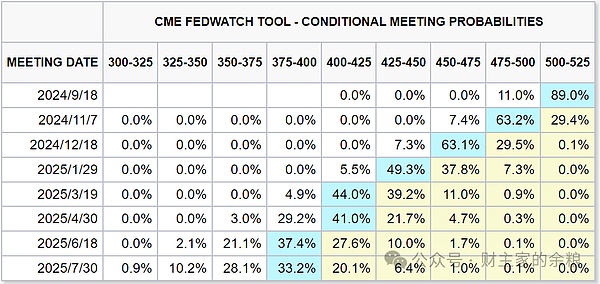Source: The surplus of the rich man's family
The Federal Reserve's July interest rate meeting ended.
Maintain the federal funds target rate in the range of 5.25%-5.50%, reduce US$25 billion/month of US Treasury bonds and US$35 billion/month of MBS, which is consistent with the resolution of the June interest rate meeting and in line with market expectations.
Compared with the June interest rate meeting statement, this Fed statement has the following differences:
1) The original assessment of strong employment has now become moderated;
2) The description of inflation has changed from "high" to "somewhat high", which is the first time since January 2024;
3) Regarding the Fed's dual mandate, it has changed from "highly attentive to inflation risk" to "attentive to both sides of its dual mandate".
To sum up, what the Fed means is -
Employment is starting to slow down, inflation is also falling, we consider the dual mission, and it is possible to cut interest rates at the next meeting.

However, please note that although the Fed admitted that it is possible to cut interest rates in September, it still emphasized data dependence and some other words, such as this sentence:
"It is not appropriate to lower the interest rate target range before there is greater confidence that the inflation rate will continue to move towards 2%."
But I feel that the market seems to have not heard it.
After the interest rate meeting, U.S. Treasury yields fell, the Nasdaq 100 index closed up 3%, and the S&P 500 index also rose 1.6%. Treasury yields fell, and the entire market seemed to be celebrating the upcoming Fed rate cut.
In fact, as early as a week ago, the market could not wait to start pricing in a 100% interest rate cut.
For example, last Friday, CME's interest rate futures showed that the probability of the Fed cutting interest rates in September was 100%.

Now, after the interest rate meeting, the market believes that the Fed has released its dovish stance, and the expectation of a rate cut is 100%.

In the financial market of the United States, the interest rate futures market had already priced in a 100% interest rate cut in September last week. Now it has reconfirmed a 100% interest rate cut in September. As a result, the stock market will still take the opportunity to surge...
Thinking back, similar situations have occurred many times in the US financial market before:
Originally, the market had anticipated a certain monetary policy of the Federal Reserve, and then the stock market surged to price in this expectation;
Then, the market expected the probability of the Federal Reserve's policy to be 100%, and then, the stock market surged again, pricing in 100%;
Then, the market expected the Federal Reserve's policy to be "set in stone", and then, the stock market surged again, pricing in a setback
Finally, the Federal Reserve confirmed the implementation of the policy, and then, the stock market surged again, and the pricing policy was implemented.
We don’t know, and we can’t ask, what is the difference between this 100%, and a done deal, and the implementation of policies?
However, as an investor, I always have doubts about things like 100%.
After all, this interest rate cut is not Newton’s classical mechanics that the earth revolves around the sun. How can it be 100% in two months?
What’s more, Newton’s mechanics has long been overturned at the microscopic level. Quantum mechanics is the real truth, and “Schrödinger’s cat” is the real norm. How can the market casually price in a 100% interest rate cut in September?
What’s more, Powell has been emphasizing at the interest rate meeting just now that he is data-dependent and needs to see the performance of the data in the next two months, whether it is inflation or employment. What if there is a certain deviation?
The Fed clearly said, "It is not appropriate to lower the target range of interest rates until there is greater confidence that the inflation rate will continue to move towards 2%." Why did the market turn a deaf ear?
It is well known that in the past two weeks, the great eight technology stocks (Apple, Microsoft, Google, Nvidia, Amazon, Facebook, Tesla, Netflix), which had been rising every day, every month, and for more than a year, have actually started to fall continuously; at the same time, small and medium-sized stocks that have been falling for more than a year have begun to rise.
In this case, the large technology stocks in the US stock market rose again last night. Does it mean that as long as the Fed releases the tone of interest rate cuts, the great eight technologies are back?
I don't think so.
No matter what the circumstances, the Fed itself has not made a 100% commitment to cut interest rates, but the market insists that there will be a 100% interest rate cut in September. As an investor, I always think that this is problematic.
 Alex
Alex





